
- Locate us Easily

-
 98, Moo 9 Yangarm,nongphai Phetchabun 67220 Thailand
98, Moo 9 Yangarm,nongphai Phetchabun 67220 Thailand
-
Open 08:30 To 17:45
Mahad Thai Global Trade Ltd: Connecting Worlds, Nourishing Lives!
Description
Botanical Name: Zizania palustris varietyOrigin: Canada/USAProduction: also known as Manoomin (harvesting berry), this annual native plant grows in shallow water in small lakes and slow-flowing streams and often only the flowering head of wild rice rises above the water. The grain is enjoyed by aquatic wildlife and was historically gathered and eaten in North America and China. Now it is a popular delicacy in North America but the grain is eaten less in China where the plant’s stem is used as a vegetable.Qualities: The nutritional quality of wild rice appears to equal or surpass that of other cereals as it has a high protein and carbohydrate content, and is very low in fat. Lysine and methionine comprise a higher percentage of the amino acids in the protein than in most other cereals and serves as an excellent source of the B vitamins: thiamine, riboflavin, and niacin.Common use: Wild rice is a nutritional grain that serves as a substitute for potatoes or rice, and is used in a wide variety of foods such as dressings, casseroles, soups, salads, and desserts. In recent years, wild rice has been used in breakfast cereals, and mixes for pancakes, muffins, and cookies. Storage: keeps well in a sealed container in a cool, dry, and dark locationDisclaimer: this information is for educational purposes only and has not been evaluated by the FDA or CFIA. It is not intended to diagnose, treat, cure, or prevent any disease. This product has been packaged in the same facility as peanuts, tree nuts, wheat, soy, and other potential allergens.
Related Products
Sign in
No account yet?
Create an Account

 Nuts & Dried Fruits
Nuts & Dried Fruits
 Meat & Poultry
Meat & Poultry



 Seeds & Pulses
Seeds & Pulses
 Spices & Herbs
Spices & Herbs
 Beverages
Beverages







